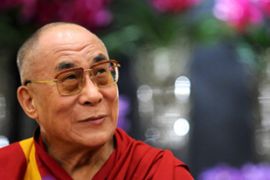Profile: The Dalai Lama
Tenzin Gyatso is Tibet’s spiritual leader in exile.

At the age of five the boy was eventually installed as the spiritual leader of Tibet in 1940, taking the name Jamphel Ngawang Lobsang Yeshe Tenzin Gyatso.
He began his monastic education at the age of six and in late 1950, after Chinese troops had entered Tibet, the Dalai Lama was made political head of state as a 15-year-old.
‘Peaceful liberation’
In 1951, Beijing announced that a Tibetan delegation had agreed to the “peaceful liberation” of Tibet by Chinese forces.
The Dalai Lama later said the agreement was forced on a delegation he had sent to the Chinese capital to persuade the government not to launch a full scale invasion.
Despite meeting Mao Zedong and other Chinese leaders in Beijing in 1954, he was unable to get Chinese troops to leave.
 |
| The Dalai Lama is not without his critics [Reuters] |
On March 10, 1959, amid a Chinese crackdown on a failed Tibetan uprising in Lhasa, and fearing for his life, the Dalai Lama fled into exile.
In the middle of winter, disguised as a soldier and accompanied by his immediate family and a small escort, he took three weeks to get from Lhasa to the border with India.
The Indian government had already agreed to provide asylum and soon after his arrival the Dalai Lama called a press conference to reject China’s “peaceful liberation” agreement of 1951.
Since then he has been living in the Himalayan town of Dharamsala, in northern India, where he set up the seat of the Tibetan political government in exile.
The Dalai Lama has received scores of honorary doctorates and awards, including the Nobel Peace Prize in 1989 for opposing violence in his quest for Tibetan autonomy.
In 2007 he was awarded the US Congressional Gold Medal, America’s highest civilian honour.
Discrimination
But while the constitution for Tibetans in exile he set up enshrines democratic principles of freedom of speech, belief, assembly and movement, the Dalai Lama is not without controversy.
He has been criticised, for example, for banning the worship of a deity called Dorje Shugden and discriminating against millions of Tibetan Buddhist Shugden worshippers.
The Tibetan government in exile say Shugden worshippers are terrorists closely linked to China, but Shugden followers in India have taken the Dalai Lama to court accusing him of religious discrimination.
China meanwhile continues to accuse the Dalai Lama of being a separatist seeking Tibet independence – he says autonomy – and of instigating riots in March this year which triggered a deadly crackdown.
Behind the scenes Chinese officials and envoys of the Dalai Lama have held a series of talks, ostensibly aimed at finding a way forward.
But despite a string of meetings, no progress has been made and last November the Dalai Lama told reporters he believed the talks process had failed, saying he had lost faith in the Chinese government.
He added that suppression inside Tibet was getting worse and he was giving up efforts to seek greater autonomy, paving the way for the Tibetan people to decide a fresh strategy for dealing with China.
At 74, the Dalai Lama has indicated that he may be ready to transfer political leadership of the government-in-exile to others, but Tibetan officials in exile have said that he intends to keep his spiritual leadership role.